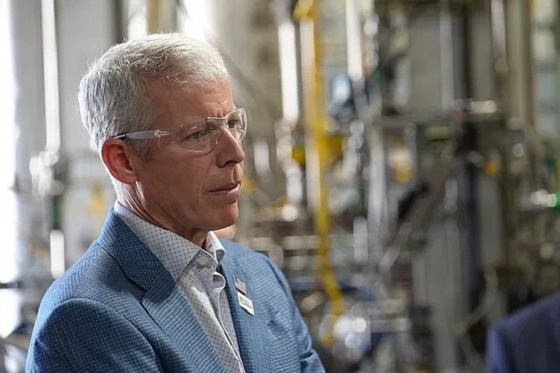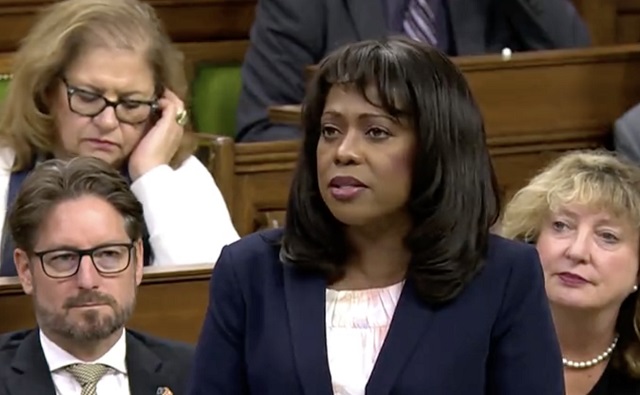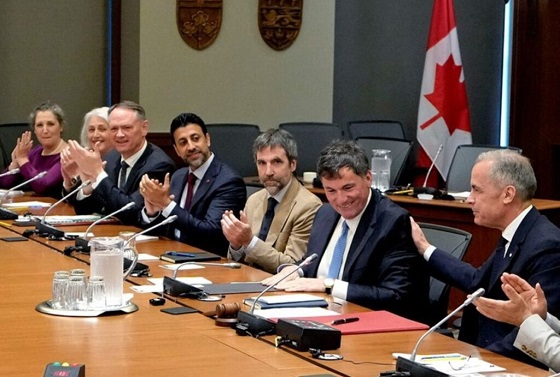Economy
Greater oil and gas export capacity will boost Canadian dollar – and productivity

From the Frontier Centre for Public Policy
By Ian Madsen
It may be overly optimistic to think that Canadian producers could reap CAD$10 in gross profit per GJ, let alone the full almost-$20 price differential. However, even if it is just $5 per GJ, that generates $90 million per day, or almost $33 billion per year.
Canada’s productivity performance has been dismal, having not increased over the last nearly ten years. Economists calculate productivity as the value of output divided by hours worked to generate that output. However, the numerator, being the value of the goods and services produced, has been either neglected, or, when it is actually addressed, is looked at from the perspective of new, ‘high tech’ products and services (information technology, artificial intelligence, or advanced equipment, materials and devices). While all these industries are important, other sectors boost value, too.
Foremost among those sectors is energy – where Canada has outstanding competitive advantages, but still does not get full value for its output. Canada’s oil exports now go entirely to the United States, mostly via pipelines from Alberta and Saskatchewan, with a small amount sent by ship from the Vancouver area to U.S. West Coast customers. All Canadian natural gas exports go entirely to the U.S., which already has a surplus.
The situation severely harms Canadian producers’ bargaining power, which causes them to experience severe discounts on natural gas and oil (whether heavy oil sands, Western Canada Select, ‘bitumen’; or conventional crude oil). Fortunately, the situation will change radically, either next year, or, possibly, later this year.
The reason: Canada LNG, the first of possibly several West Coast liquefied natural gas liquefaction export terminals, should soon commence shipments to foreign buyers (South Korean, Japanese utilities, and others in East Asia). The export capacity of the Kitimat, BC, facility is 1.8 billion cubic feet daily, or 1.8 million Gigajoules, ‘GJ’.
Natural gas now sells for about $2.50/GJ Canadian in Alberta, whereas East Asian recent prices were US$16.70: about CAD$22.25. (It costs several dollars to liquify, load, transport and re-gasify at destination each GJ.) Every dollar of after-cost price differential flows directly to producers, and Canada’s balance of payments. The balance of payments determines our loonie’s value, and, thus, Canada’s standard of living (also, to some extent, inflation).
It may be overly optimistic to think that Canadian producers could reap CAD$10 in gross profit per GJ, let alone the full almost-$20 price differential. However, even if it is just $5 per GJ, that generates $90 million per day, or almost $33 billion per year. As total exports were $596.9 billion in 2022, this would constitute an increase of about 5.5%. This amounts to roughly $1,610 per person in Canada’s current 20.5 million-strong labour force – a big productivity increase for ‘little’ extra work (as everything will have already been built).
Yet, that is not all. There is also the TransMountain, ‘TMX’, pipeline expansion, scheduled for completion this year. Its extra capacity of 590,000 barrels per day is all slated to be exported. If ‘just’ $10 extra per barrel is garnered (the U.S. heavy oil differential exceeds that, typically), that would bring $5.9 million more per day: $2.15 billion annually.
This would also contribute to a better balance of payments (perhaps becoming positive once more), a higher loonie, higher productivity, lower inflation, and a higher standard of living. Australia, which now outperforms Canada, does not interfere with its own massive LNG exports. If Canadian politicians can restrain themselves from blocking more oil or gas pipelines and LNG export terminals, a bright future awaits.
Ian Madsen is the Senior Policy Analyst at the Frontier Centre for Public Policy
Watch Ian Madsen on Frontier Live on X here.
Economy
What the Data Shows About the New Canada-Alberta Pipeline Opportunity

From Energy Now
By Canada Powered by Women
Canada has entered a new period of energy cooperation, marking one of the biggest shifts in federal–provincial alignment on energy priorities in years.
Last week as Prime Minister Mark Carney and Alberta Premier Danielle Smith signed a memorandum of understanding (MOU) that outlines how both governments will approach a potential pipeline to British Columbia’s coast.
The agreement, which has been described as a “new starting point” after years of tension, lays the groundwork for a privately financed pipeline while also linking this commitment to a broader set of infrastructure priorities across oil and gas, LNG, renewables, critical minerals and electricity transmission.
It also sets out how a privately financed project, moving roughly 300,000 to 400,000 barrels of oil to global markets each day, will be reviewed.
Now that the announcement is behind us, attention has turned to how (or if) a pipeline is going to get built.
Alberta has set out its ambitions, British Columbia has its conditions, and the federal government has its own expectations. Together, these positions are shaping what some are calling a “grand bargain” which will be made up of trade-offs.
Trade-offs are not a new concept for the engaged women that Canada Powered by Women (CPW) represents, as they’ve been showing up in our research for several years now. And anyone who reads us also knows we like to look at what the data says.
According to new polling from the Angus Reid Institute, a clear majority of Canadians support a pipeline, with national backing above 60 per cent. And there’s strong support for the pipeline among those in B.C. This aligns with other emerging data points that show Canadians are looking for practical solutions that strengthen affordability and long-term reliability.
By the numbers:
• 60 per cent of Canadians support the pipeline concept, while 25 per cent oppose it.
• 53 per cent of people support in British Columbia, compared to 37 percent opposed.
• 74 per cent of people in Alberta and Saskatchewan support the pipeline.

Our research shows the same trends.
A large majority (85 per cent) of engaged women agree that building pipelines and refining capacity within the country should be prioritized. They favour policies that will progress stability, affordability and long-term economic opportunity.
A key feature of the MOU is the expectation of Indigenous ownership and benefit sharing, which Alberta and B.C. governments identify as essential, and which aligns with public opinion. As of right now, Indigenous groups remain split on support for a pipeline.
The agreement also signals that changes to the federal Oil Tanker Moratorium Act may need to be considered. The moratorium, in place since 2019, is designed to limit large tanker traffic on the North Coast of B.C. because of navigation risks in narrow channels and the need to protect sensitive coastal ecosystems.
Those in favour of the pipeline point to this as a critical barrier to moving Canadian oil to international markets.
Polling from the Angus Reid Institute shows that 47 per cent of Canadians believe the moratorium could be modified or repealed if stronger safety measures are in place. Again, we come back to trade-offs.
The MOU is a starting point and does not replace consultation, environmental review or provincial alignment. These steps are still required before any project can advance. Taken together, the agreement and the data show broad support for strengthening Canada’s energy options.
This will be an issue that engaged women are no doubt going to watch, and the conversation is likely to move from ideas to discussing what trade-offs can be made to bring this opportunity to life.
Business
US Energy Secretary says price of energy determined by politicians and policies


From the Daily Caller News Foundation
During the latest marathon cabinet meeting on Dec. 2, Energy Secretary Chris Wright made news when he told President Donald Trump that “The biggest determinant of the price of energy is politicians, political leaders, and polices — that’s what drives energy prices.”
He’s right about that, and it is why the back-and-forth struggle over federal energy and climate policy plays such a key role in America’s economy and society. Just 10 months into this second Trump presidency, the administration’s policies are already having a profound impact, both at home and abroad.
While the rapid expansion of AI datacenters over the past year is currently being blamed by many for driving up electric costs, power bills were skyrocketing long before that big tech boom began, driven in large part by the policies of the Obama and Biden administration designed to regulate and subsidize an energy transition into reality. As I’ve pointed out here in the past, driving up the costs of all forms of energy to encourage conservation is a central objective of the climate alarm-driven transition, and that part of the green agenda has been highly effective.
Dear Readers:
As a nonprofit, we are dependent on the generosity of our readers.
Please consider making a small donation of any amount here.
Thank you!
President Trump, Wright, and other key appointees like Interior Secretary Doug Burgum and EPA Administrator Lee Zeldin have moved aggressively throughout 2025 to repeal much of that onerous regulatory agenda. The GOP congressional majorities succeeded in phasing out Biden’s costly green energy subsidies as part of the One Big Beautiful Bill Act, which Trump signed into law on July 4. As the federal regulatory structure eases and subsidy costs diminish, it is reasonable to expect a gradual easing of electricity and other energy prices.
This year’s fading out of public fear over climate change and its attendant fright narrative spells bad news for the climate alarm movement. The resulting cracks in the green facade have manifested rapidly in recent weeks.
Climate-focused conflict groups that rely on public fears to drive donations have fallen on hard times. According to a report in the New York Times, the Sierra Club has lost 60 percent of the membership it reported in 2019 and the group’s management team has fallen into infighting over elements of the group’s agenda. Greenpeace is struggling just to stay afloat after losing a huge court judgment for defaming pipeline company Energy Transfer during its efforts to stop the building of the Dakota Access Pipeline.
350.org, an advocacy group founded by Bill McKibben, shut down its U.S. operations in November amid funding woes that had forced planned 25 percent budget cuts for 2025 and 2026. Employees at EDF voted to form their own union after the group went through several rounds of budget cuts and layoffs in recent months.
The fading of climate fears in turn caused the ESG management and investing fad to also fall out of favor, leading to a flood of companies backtracking on green investments and climate commitments. The Net Zero Banking Alliance disbanded after most of America’s big banks – Goldman Sachs, J.P. Morgan Chase, Citigroup, Wells Fargo and others – chose to drop out of its membership.
The EV industry is also struggling. As the Trump White House moves to repeal Biden-era auto mileage requirements, Ford Motor Company is preparing to shut down production of its vaunted F-150 Lightning electric pickup, and Stellantis cancelled plans to roll out a full-size EV truck of its own. Overall EV sales in the U.S. collapsed in October and November following the repeal of the $7,500 per car IRA subsidy effective Sept 30.
The administration’s policy actions have already ended any new leasing for costly and unneeded offshore wind projects in federal waters and have forced the suspension or abandonment of several projects that were already moving ahead. Capital has continued to flow into the solar industry, but even that industry’s ability to expand seems likely to fade once the federal subsidies are fully repealed at the end of 2027.
Truly, public policy matters where energy is concerned. It drives corporate strategies, capital investments, resource development and movement, and ultimately influences the cost of energy in all its forms and products. The speed at which Trump and his key appointees have driven this principle home since Jan. 20 has been truly stunning.
David Blackmon is an energy writer and consultant based in Texas. He spent 40 years in the oil and gas business, where he specialized in public policy and communications.
-

 Censorship Industrial Complex2 days ago
Censorship Industrial Complex2 days agoConservative MP Leslyn Lewis slams Liberal plan targeting religious exemption in hate speech bil
-

 Business2 days ago
Business2 days agoCanada’s climate agenda hit business hard but barely cut emissions
-

 Health2 days ago
Health2 days agoNews RFK Jr.’s vaccine committee to vote on ending Hepatitis B shot recommendation for newborns
-

 International1 day ago
International1 day agoFBI may have finally nabbed the Jan. 6 pipe bomber
-

 Bruce Dowbiggin1 day ago
Bruce Dowbiggin1 day agoIntegration Or Indignation: Whose Strategy Worked Best Against Trump?
-

 Health2 days ago
Health2 days ago23,000+ Canadians died waiting for health care in one year as Liberals pushed euthanasia
-

 MAiD1 day ago
MAiD1 day ago101-year-old woman chooses assisted suicide — press treats her death as a social good
-

 Business1 day ago
Business1 day agoCarney’s Toronto cabinet meetings cost $530,000






